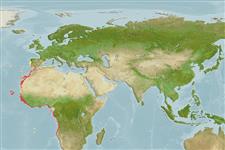Classification / Names
Common names from other countries
Main reference
Size / Weight / Age
Max length : 50.0 cm TL male/unsexed; (Ref. 57395); common length : 25.0 cm TL male/unsexed; (Ref. 6946); max. reported age: 7 years (Ref. 52657)
Environment
Marine; brackish; demersal; depth range 10 - 100 m (Ref. 6946)
Climate / Range
Subtropical, preferred 27°C (Ref. 107945); 47°N - 14°S, 27°W - 14°E
Distribution
Short description
Dorsal
spines
(total): 12;
Dorsal
soft rays
(total): 15-16;
Anal
spines: 3;
Anal
soft rays: 11 - 13;
Vertebrae: 27. Diagnosis: body oblong; snout short, about equal to eye diameter; mouth small, maxilla not reaching anterior edge of eye; 2 anterior pores on chin, followed by a median pit; third anal fin spine equal or longer than second; 11-13 anal soft rays; caudal fin forked; scales slightly ctenoid; 7-8 scale rows between lateral line and middle of spinous dorsal-fin base (Ref. 57395).
Coloration: back dark brown, silvery white on belly; sometimes large dark spots on back and flanks, but never small spots or bands; a black spot at upper angle of opercle (Ref. 57395).
IUCN Red List Status (Ref. 115185)
Threat to humans
Harmless
Human uses
Fisheries: minor commercial
More information
ReferencesAquacultureAquaculture profileStrainsGeneticsAllele frequenciesHeritabilityDiseasesProcessingMass conversion
Tools
Special reports
Download XML
Internet sources
Estimates of some properties based on models
Phylogenetic diversity index
PD50 = 0.5000 many relatives (e.g. carps) 0.5 - 2.0 few relatives (e.g. lungfishes)
Trophic Level
3.8 ±0.52 se; Based on food items.
Resilience
Medium, minimum population doubling time 1.4 - 4.4 years (Tmax=7; K=0.22)
Vulnerability
Moderate vulnerability (40 of 100)
Price category
